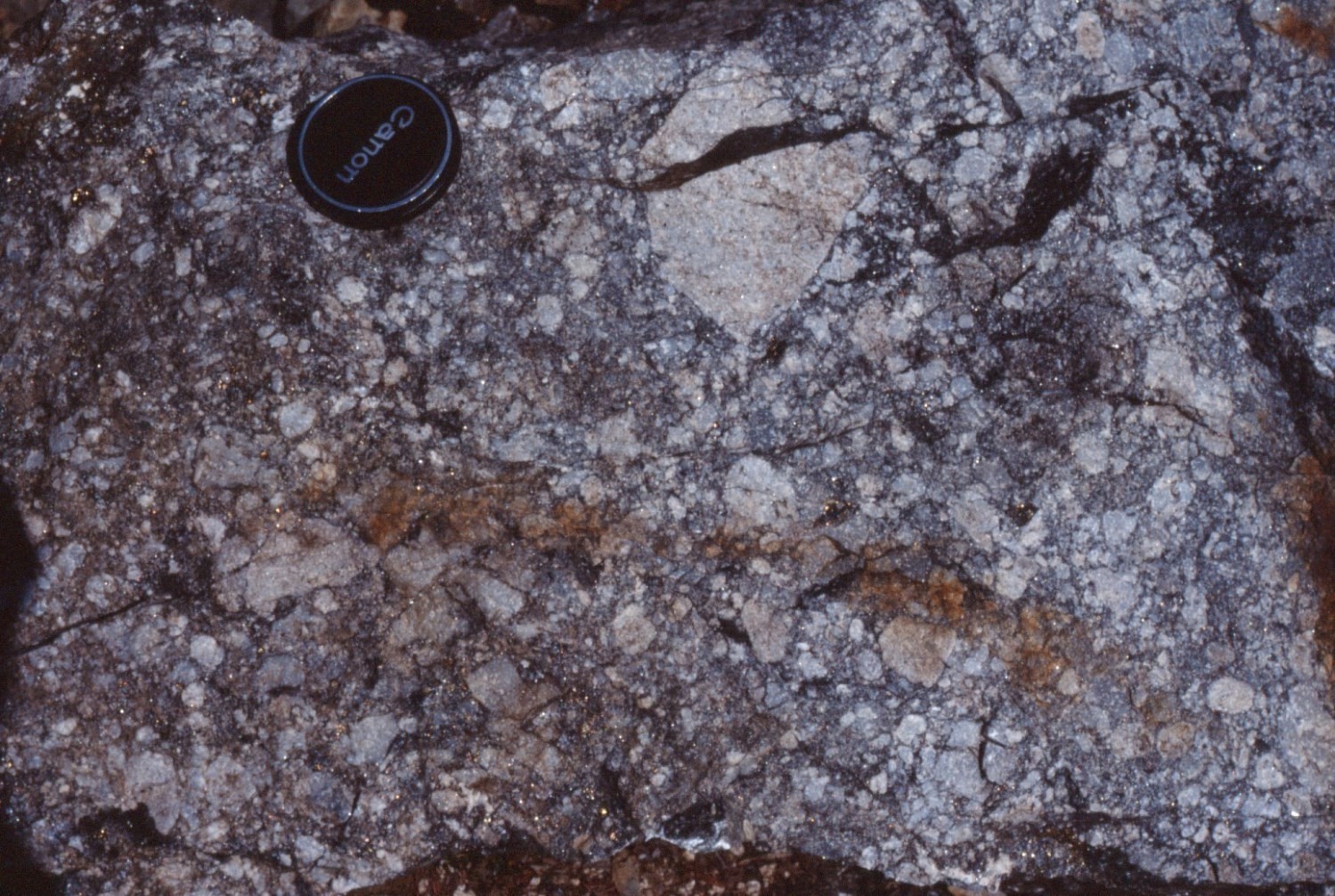
DISCLAIMER: This English version is translated from the original French. In case of any discrepancy, the French version shall prevail.
| Author(s): | Kearvell, 1985; Clark, 1986; Kearvell and Clark, 1988 |
| Age: | Paleoproterozoic |
| Stratotype: | None |
| Type area: | Mistamisk and Romanet lakes area (NTS sheets 24B05 and 24C08) |
| Geological province: | Churchill Province |
| Geological subdivision: | New Quebec Orogen (Labrador Trough) / Romanet (formerly Wheeler) Lithotectonic Zone / Lac Romanet Horst |
| Lithology: | Intrusive-hydrothermal breccia and metasomatic rocks |
| Category: | Lithodemic |
| Rank: | Complex |
| Status: | Formal |
| Use: | Active |
None
Background
The Mistamisk Complex is part of the Romanet (formerly Wheeler) Lithotectonic Zone and located in the Mistamisk and Romanet lakes area (sheets 24B05 and 24C08). The name Mistamisk Complex was proposed during the regional geological compilation of the Labrador Trough that generated the interactive geological map of Quebec. Some of the lithofacies within the complex were initially recognized during regional geological surveys conducted by Dimroth (1978). Later, the extent and variations of the unit were documented in detailed geological studies undertaken by Kearvell (1985), Clark (1986) and Kearvell and Clark (1988).
Description
The Mistamisk Complex outcrops within the Lac Romanet Horst, a large NW-SE oriented structure bounded by steep or dipping faults (sheets 24B04, 24B05 and 24C08). Prior to the formation of the horst, basalt of the Swampy Bay Group and sedimentary rocks of the Seward Group covered the horst rocks in continuity (Dimroth, 1978).
The Mistamisk Complex comprises various sodic lithofacies of hydrothermal origin: albitic or chloritic matrix breccia, albitic clusters and albitic veins (pPmik1); carbonate matrix breccia (pPmik2); laminated albitic rocks (pPmik3); albitic sodic diorite clusters (pPmik4); and various undivided albitic rocks (pPmik) (Kearvell, 1985; Clark, 1986; Kearvell and Clark, 1988). Kearvell (1985) proposed that albitic matrix breccias are of intrusive and explosive origin. Based on the texture of fragments in albitic matrix breccias, albitization of fragments occurred during metasomatism of the protolith, prior to the breccia’s intrusion. To explain the presence of slate cleavage in some fragments, Kearvell (1985) proposed that breccias were emplaced after part of regional deformation, but before the final phase. Citing several field evidences, the same author suggested that carbonate matrix breccias are also of intrusive and explosive origin and formed by rebrecciation of albite matrix breccia.
The albitization phenomenon seems to be related to an episode of syntectonic metasomatism during which sodic fluids would have circulated through the various lithofacies of the Lac Romanet Horst (Kish and Cuney, 1981; Clark, 1986). The presence of finely disseminated hematite in association with albitic alteration would indicate that fluids were also oxidizing. Sodic alteration is possibly related to the presence of evaporitic sedimentary rocks in the lower part of the first volcano-sedimentary cycle. Indeed, the presence of albite-sericite sodic schist in the Lace Lake Formation adjacent to copper and radioactive mineralization on the Romanet River shoreline was reported by Kish and Cuney (1981). The presence of evaporites was also proposed by Dimroth (1978).
The Mistamisk Complex is associated with an impressive number of known mineralized zones (Clark, 1986; Clark and Wares, 2004). These are both uranium-bearing (Eagle, Simon, GM) and copper-bearing (Delhi Pacific, Lomer Copper, Lac Taché), while some display high gold and silver contents (e.g. Eagle, Kish, GM, Delhi Pacific, Lac Taché). Copper-bearing sulphides and uranium minerals are thought to have precipitated during the sodic metasomatism event. This alteration would have resulted from the passage of hydrothermal fluids possibly derived from evaporitic sediments during the Hudsonian orogenesis (Kish and Cuney, 1981). The oxidizing and carbonate composition of hydrothermal fluids would have played an important role in the transport of uranium in solution (Kish and Cuney, 1981). A link to iron oxide-copper-gold (IOCG) mineralization was proposed (Clark and Wares, 2004; Conliffe et al., 2019).
Mistamisk Complex, Undivided (pPmik): Intrusive-Hydrothermal Polygenetic Albite Breccia with Albitic, Chloritic or Carbonate Matrix, Locally Containing Radioactive Minerals and/or Sulphides; Albite Clusters and Veins; Laminated Albitic Rock
This undivided unit, which occurs in several locations between the Du Chambon and Romanet lakes (sheets 24B05 and 24C08) comprises all the lithofacies of the Mistamisk Complex, i.e. albitic breccias with an albitic and/or chloritic matrix, albitic breccias with a carbonate matrix, albitic clusters and veins, and laminated albitic rocks.
Mistamisk Complex 1 (pPmik1): Intrusive-Hydrothermal Polygenetic Albite Breccia with Albitic and/or Chloritic Matrix, Locally Containing Radioactive Minerals and/or Sulphides; Albite Clusters; Albititic Veins Containing Radioactive Minerals; Common Reddish Hematitic Alteration
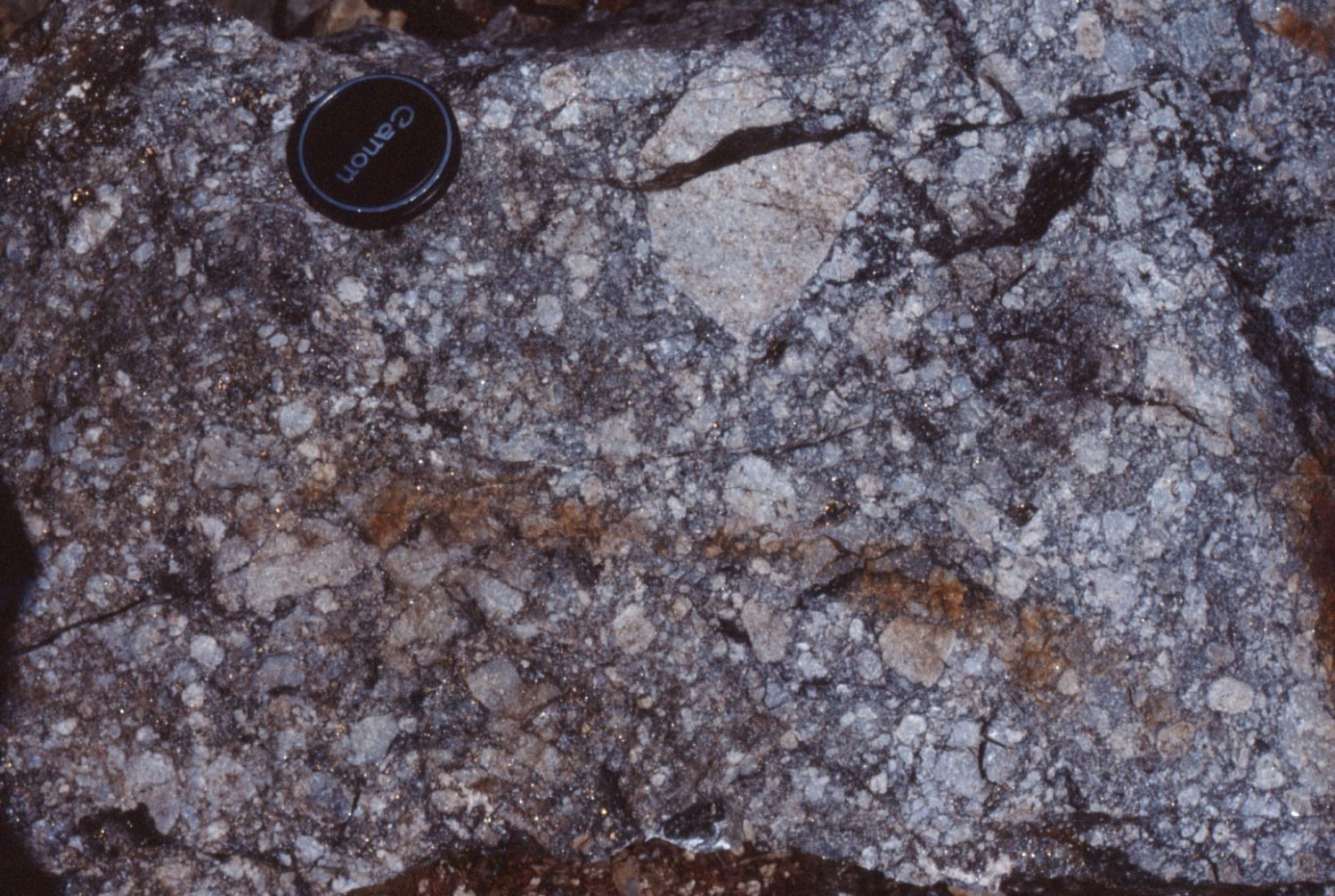
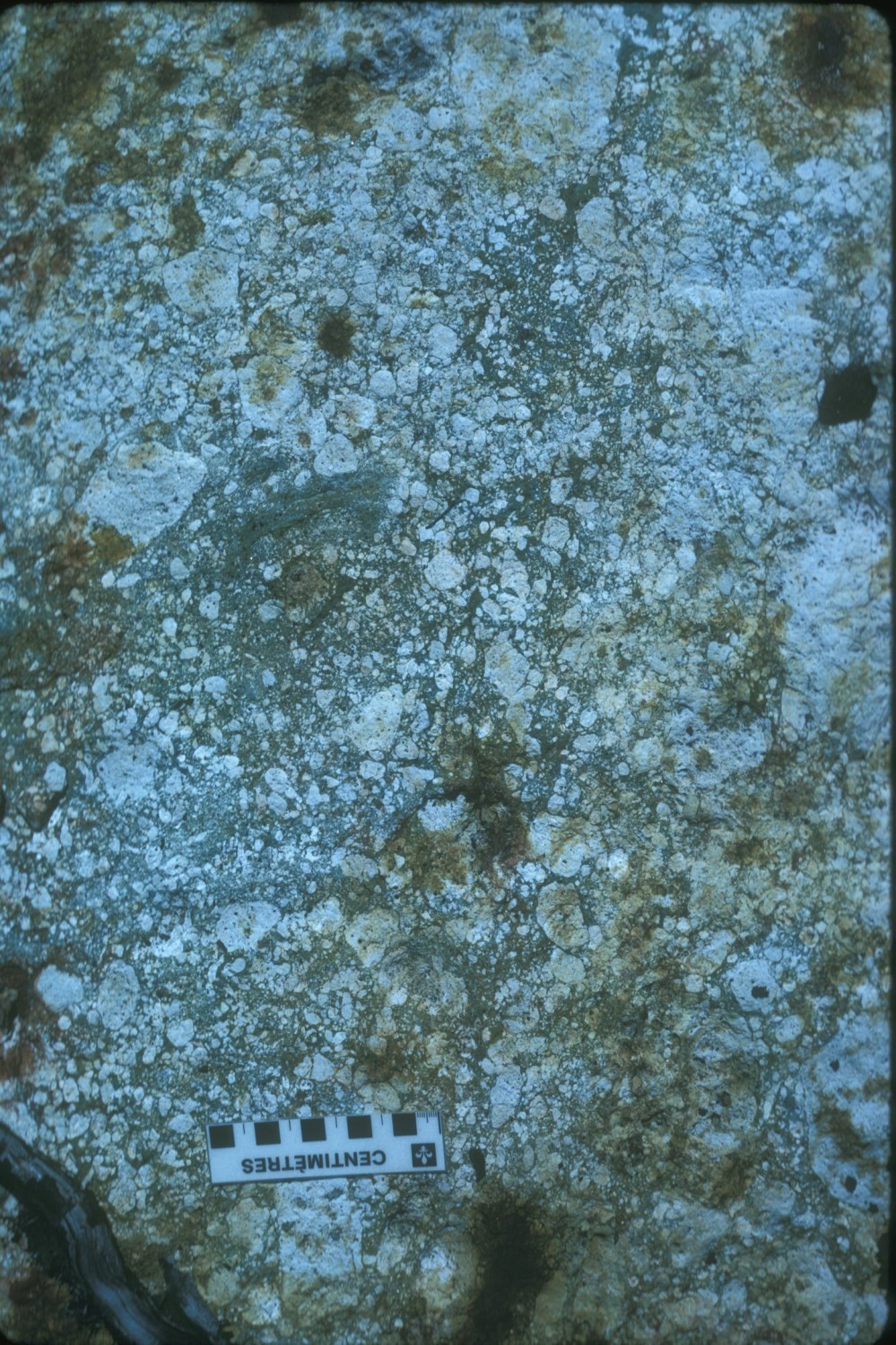
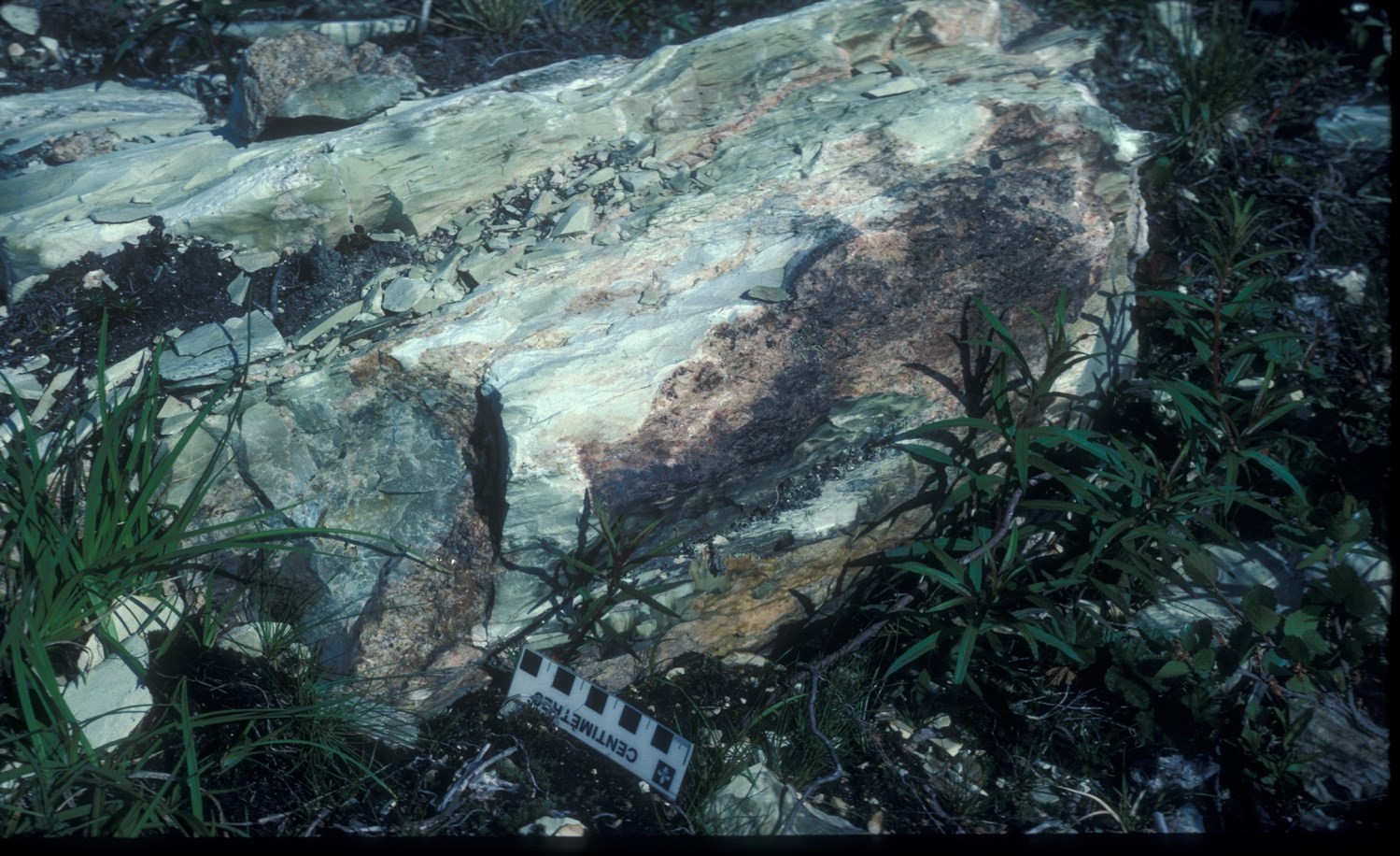 Albitic matrix breccias are common near the Romanet River (sheet 24B05; Kearvell, 1985; Clark, 1986). These breccias occur as irregular clusters or dykes generally at lithological contacts or near faults. Breccia clusters and dykes range in width from a few centimetres to hundreds of metres. One dyke near the Romanet River is ~1 km long (sheet 24B05). Highly altered fragments consist of fine albite having a white patina. They are rounded or angular and range in size from a few millimetres to >15 cm (average 3-4 cm). The nature of less altered fragments is polygenetic: sedimentary, basaltic or gabbroic. Fragments are hosted in an albite matrix accompanied by chlorite, actinolite, quartz and carbonate in variable amounts. The transition from an albitic to a carbonate matrix may be sharp or gradual (Kearvell, 1985). Locally, breccias contain sulphides (mainly pyrite and chalcopyrite) and, where carbonate is present, radioactive minerals.
Albitic matrix breccias are common near the Romanet River (sheet 24B05; Kearvell, 1985; Clark, 1986). These breccias occur as irregular clusters or dykes generally at lithological contacts or near faults. Breccia clusters and dykes range in width from a few centimetres to hundreds of metres. One dyke near the Romanet River is ~1 km long (sheet 24B05). Highly altered fragments consist of fine albite having a white patina. They are rounded or angular and range in size from a few millimetres to >15 cm (average 3-4 cm). The nature of less altered fragments is polygenetic: sedimentary, basaltic or gabbroic. Fragments are hosted in an albite matrix accompanied by chlorite, actinolite, quartz and carbonate in variable amounts. The transition from an albitic to a carbonate matrix may be sharp or gradual (Kearvell, 1985). Locally, breccias contain sulphides (mainly pyrite and chalcopyrite) and, where carbonate is present, radioactive minerals.
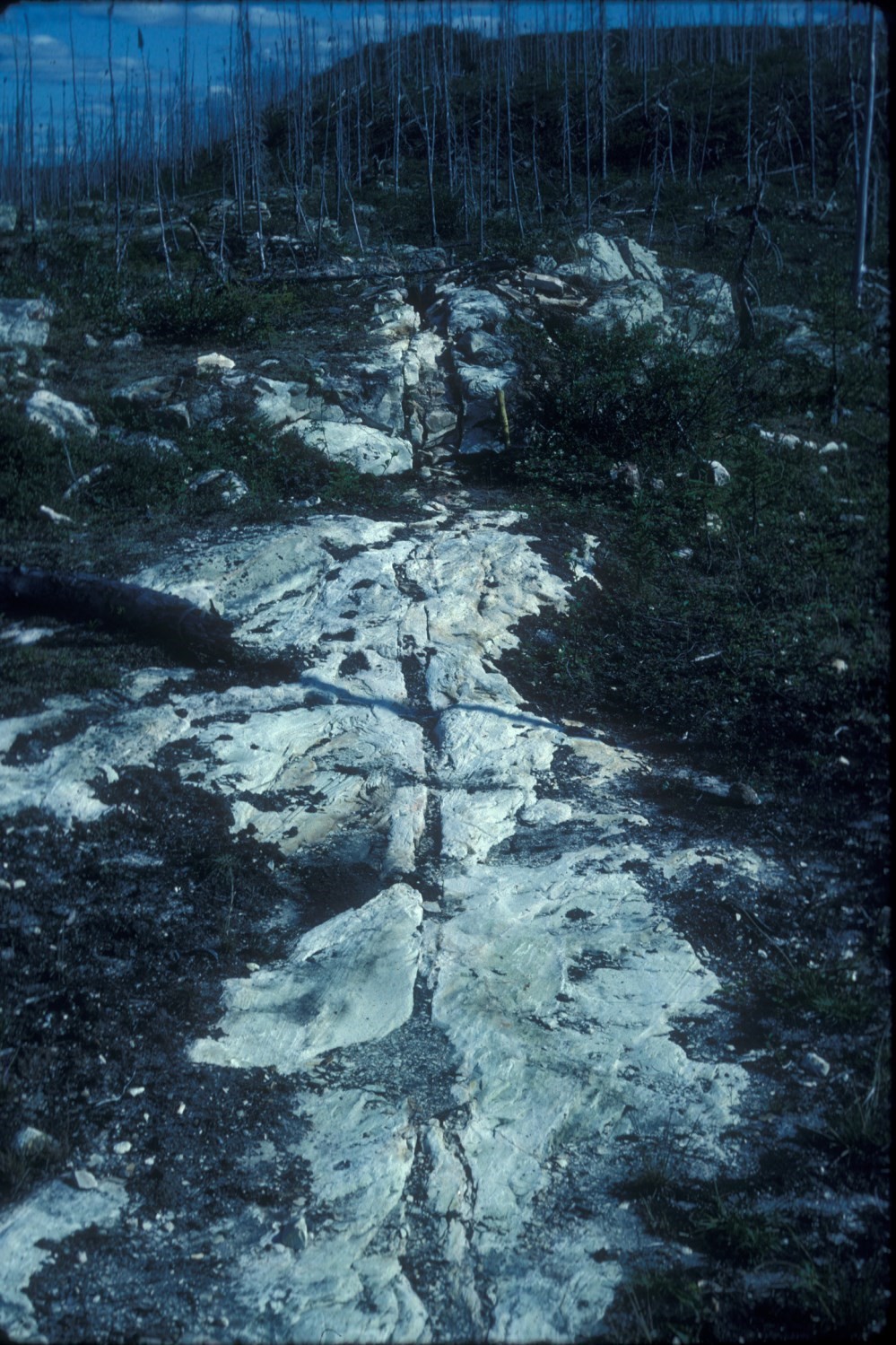 In some places, centimetre-wide, medium-grained albite veins intrude the surrounding sedimentary rocks from albite matrix breccia along a cleavage (Kearvell, 1985). These veins are composed of albite with local carbonate and quartz. Some veins are radioactive. Other albite veins have no apparent spatial association with albite breccia. Albitic veins are interpreted as being of hydrothermal origin. Some fine to medium-grained albite clusters occur in sedimentary rocks near albitic veins, and these clusters preserve remnants of sedimentary laminae. This field evidence indicates that brecciation and emplacement of albite veins occurred after the formation of the cleavage (Clark, 1986). The walls of albititc matrix breccias and albite veins, whether sedimentary or mafic igneous rocks, are commonly altered. This albitic alteration also occurs in places where albitic breccias and veins are not abundant. Hematitic alteration, giving a reddish colour to the affected rocks, commonly accompanies albitization.
In some places, centimetre-wide, medium-grained albite veins intrude the surrounding sedimentary rocks from albite matrix breccia along a cleavage (Kearvell, 1985). These veins are composed of albite with local carbonate and quartz. Some veins are radioactive. Other albite veins have no apparent spatial association with albite breccia. Albitic veins are interpreted as being of hydrothermal origin. Some fine to medium-grained albite clusters occur in sedimentary rocks near albitic veins, and these clusters preserve remnants of sedimentary laminae. This field evidence indicates that brecciation and emplacement of albite veins occurred after the formation of the cleavage (Clark, 1986). The walls of albititc matrix breccias and albite veins, whether sedimentary or mafic igneous rocks, are commonly altered. This albitic alteration also occurs in places where albitic breccias and veins are not abundant. Hematitic alteration, giving a reddish colour to the affected rocks, commonly accompanies albitization.
Mistamisk Complex 2 (pPmik2): Intrusive-Hydrothermal Polygenetic Albitic Breccia with Carbonate Matrix, Commonly Sulphide-Bearing
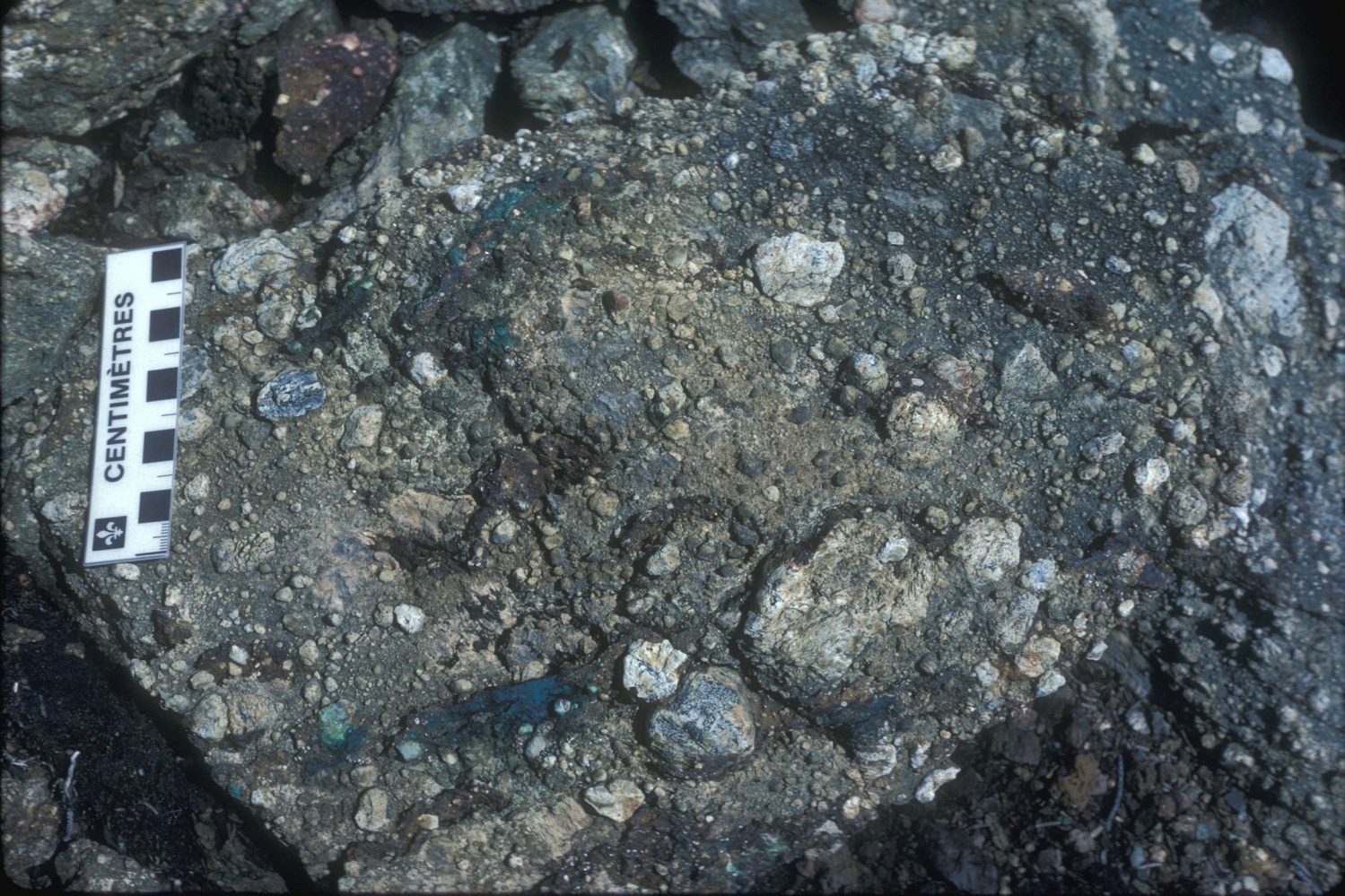
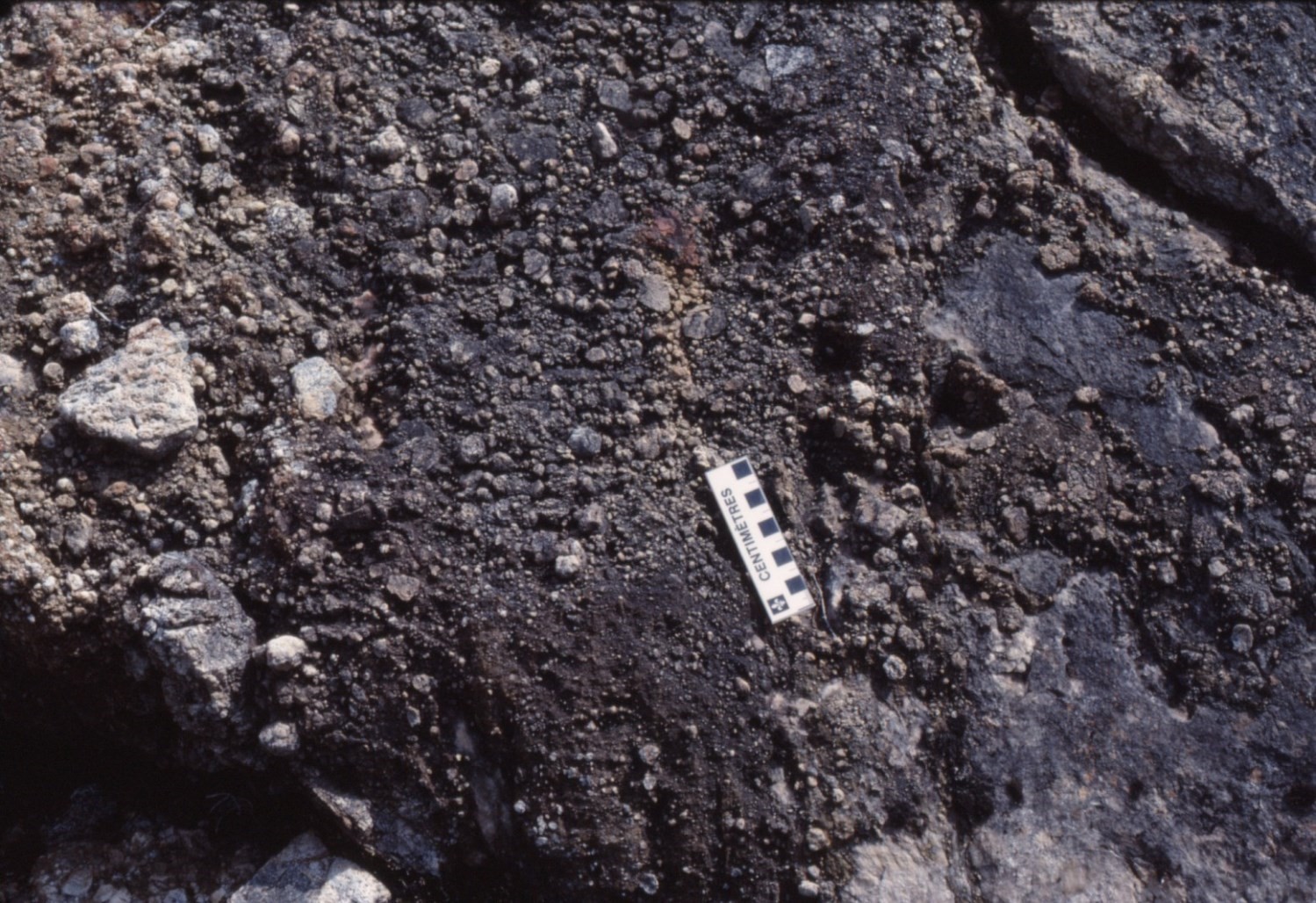
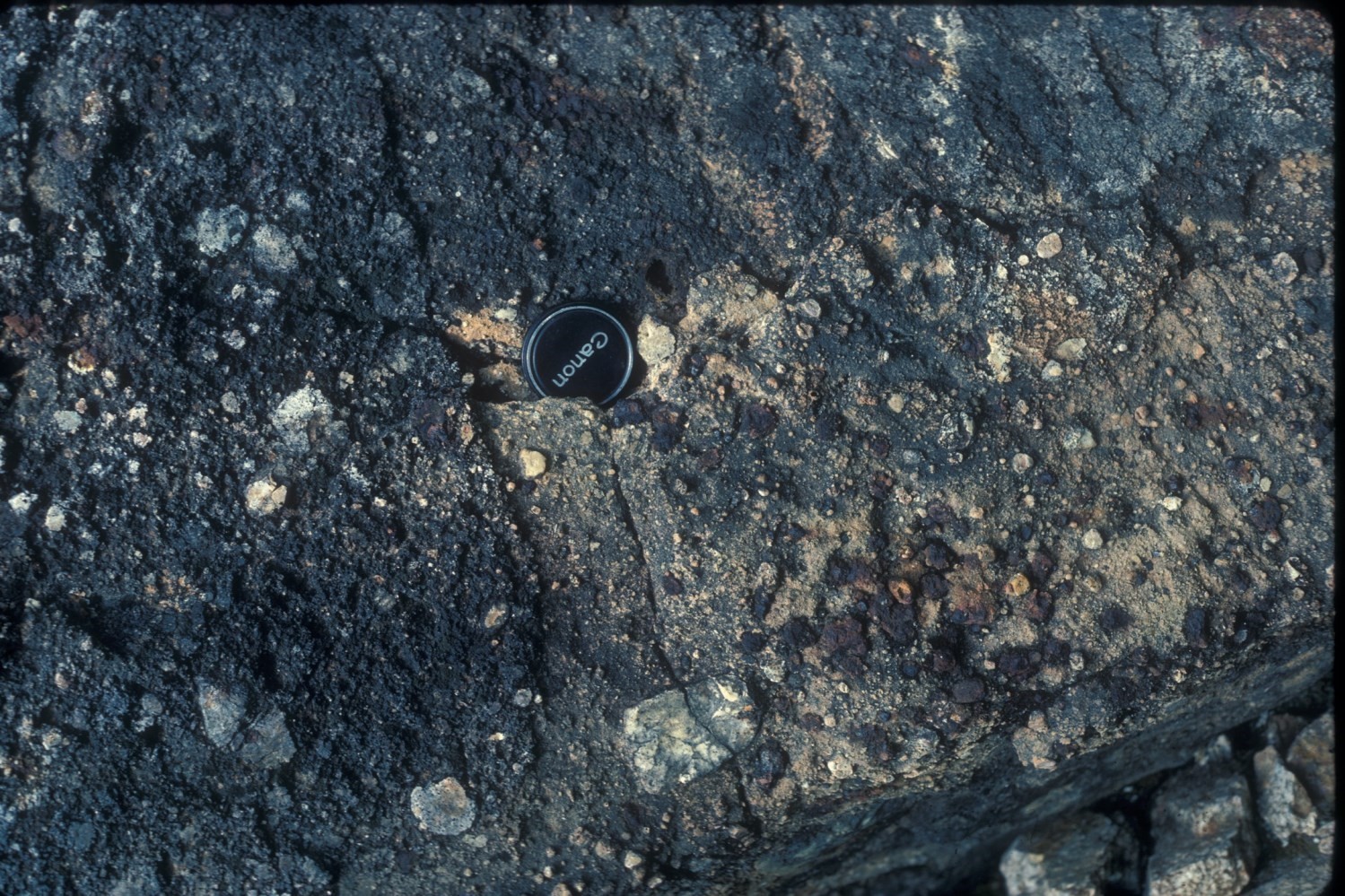 Carbonate matrix breccias are particularly abundant between Du Chambon Lake and the Romanet River (sheets 24B05 and 24C08; Kearvell, 1985). Dimroth (1978) uses the terms « sandstone pebble conglomerate » or « nodular quartzite », but Kearvell and Clark (1988) concluded that they are breccias of hydrothermal-intrusive origin. Outcrops of this « conglomerate » that Kearvell and Clark (1988) did not visit were classified as the undivided unit (pPmik). Fragments are subangular to rounded and make up to 85% of the rock. They are commonly 1 to 5 cm in diameter, but range in size from 1 mm to 60 cm. They are polygenetic. Depending on the location, fragments of the following lithofacies occur: albitic rock, orange dolomite, quartz-mica schist, mafic rock, pink to white arenite, greenish grey rock, white quartzite, laminated siltslate, yellowish quartzofeldspathic rock, green phyllite, chlorite schist and pink « cherty » rock. Locally, these breccias include fragments of albite matrix breccia (Kearvell, 1985). The matrix is composed of fine to coarse carbonate (dolomite, siderite or both) having an orange-brown patina. Breccias are generally mineralized in sulphides (4-20%), mainly pyrite locally accompanied by chalcopyrite and magnetite.
Carbonate matrix breccias are particularly abundant between Du Chambon Lake and the Romanet River (sheets 24B05 and 24C08; Kearvell, 1985). Dimroth (1978) uses the terms « sandstone pebble conglomerate » or « nodular quartzite », but Kearvell and Clark (1988) concluded that they are breccias of hydrothermal-intrusive origin. Outcrops of this « conglomerate » that Kearvell and Clark (1988) did not visit were classified as the undivided unit (pPmik). Fragments are subangular to rounded and make up to 85% of the rock. They are commonly 1 to 5 cm in diameter, but range in size from 1 mm to 60 cm. They are polygenetic. Depending on the location, fragments of the following lithofacies occur: albitic rock, orange dolomite, quartz-mica schist, mafic rock, pink to white arenite, greenish grey rock, white quartzite, laminated siltslate, yellowish quartzofeldspathic rock, green phyllite, chlorite schist and pink « cherty » rock. Locally, these breccias include fragments of albite matrix breccia (Kearvell, 1985). The matrix is composed of fine to coarse carbonate (dolomite, siderite or both) having an orange-brown patina. Breccias are generally mineralized in sulphides (4-20%), mainly pyrite locally accompanied by chalcopyrite and magnetite.
Mistamisk Complex 3 (pPmik3): Laminated Beige, Grey, Pink or Black Albitic Rock, Locally Sulphide-Bearing
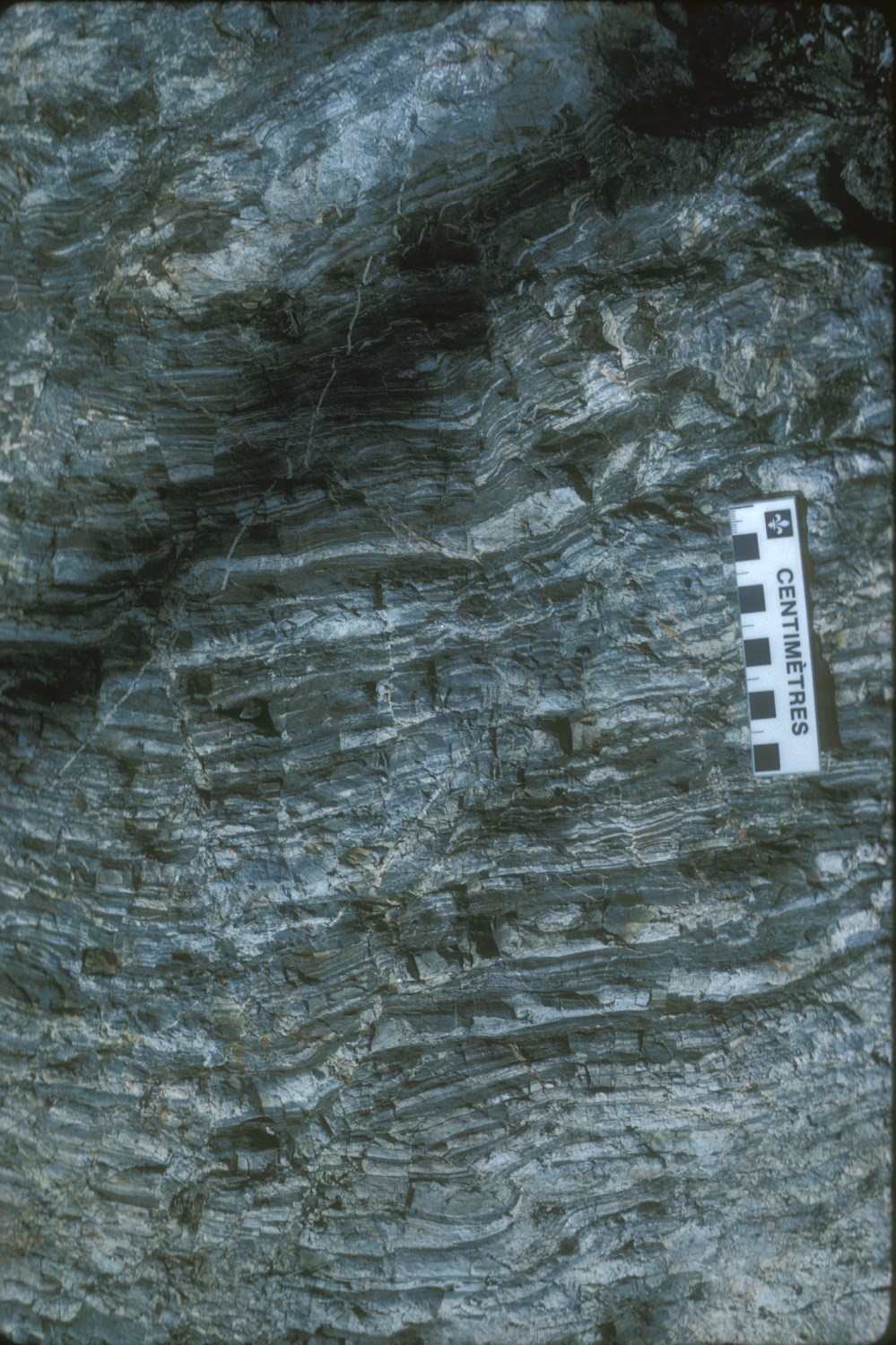
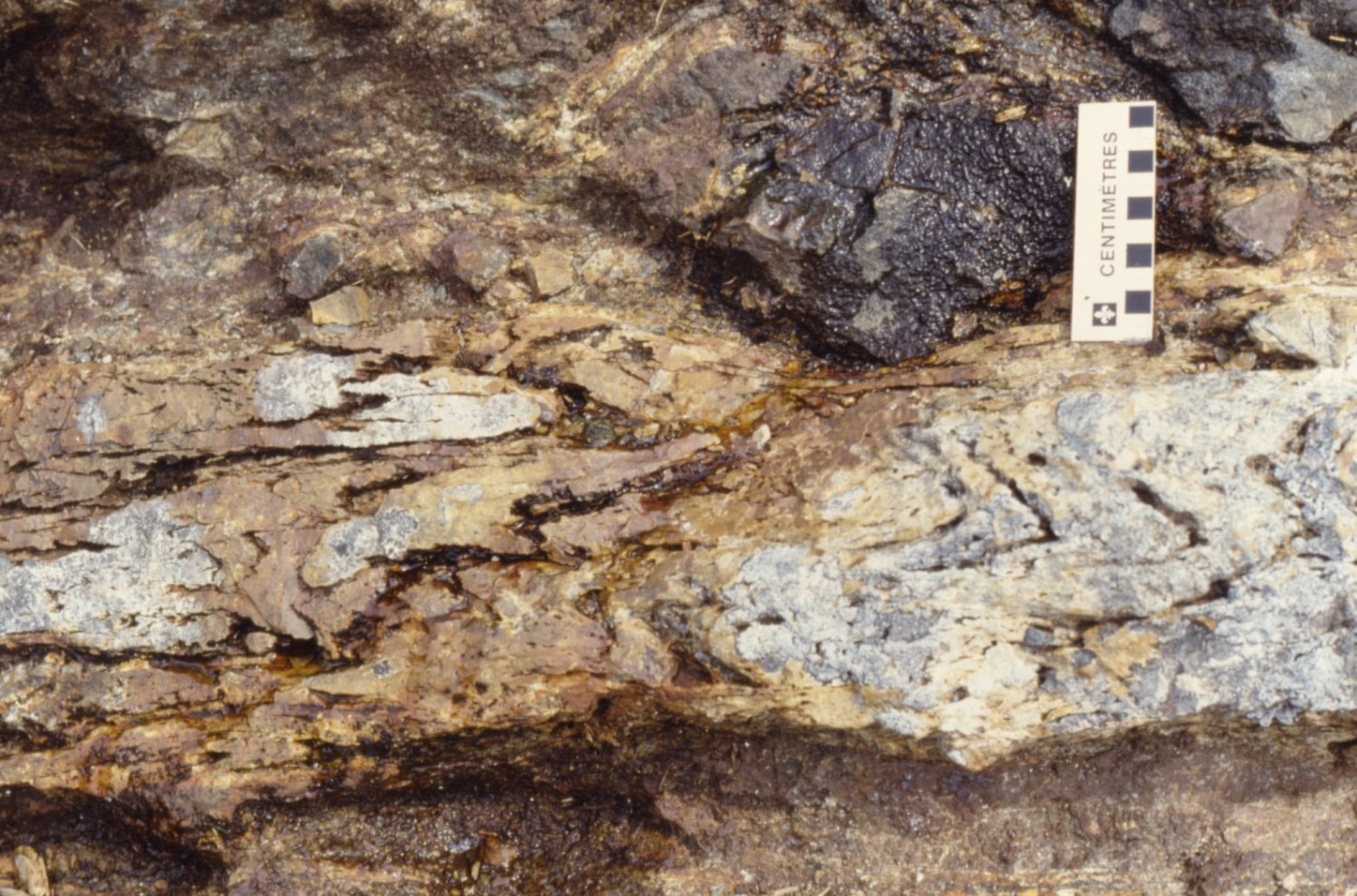
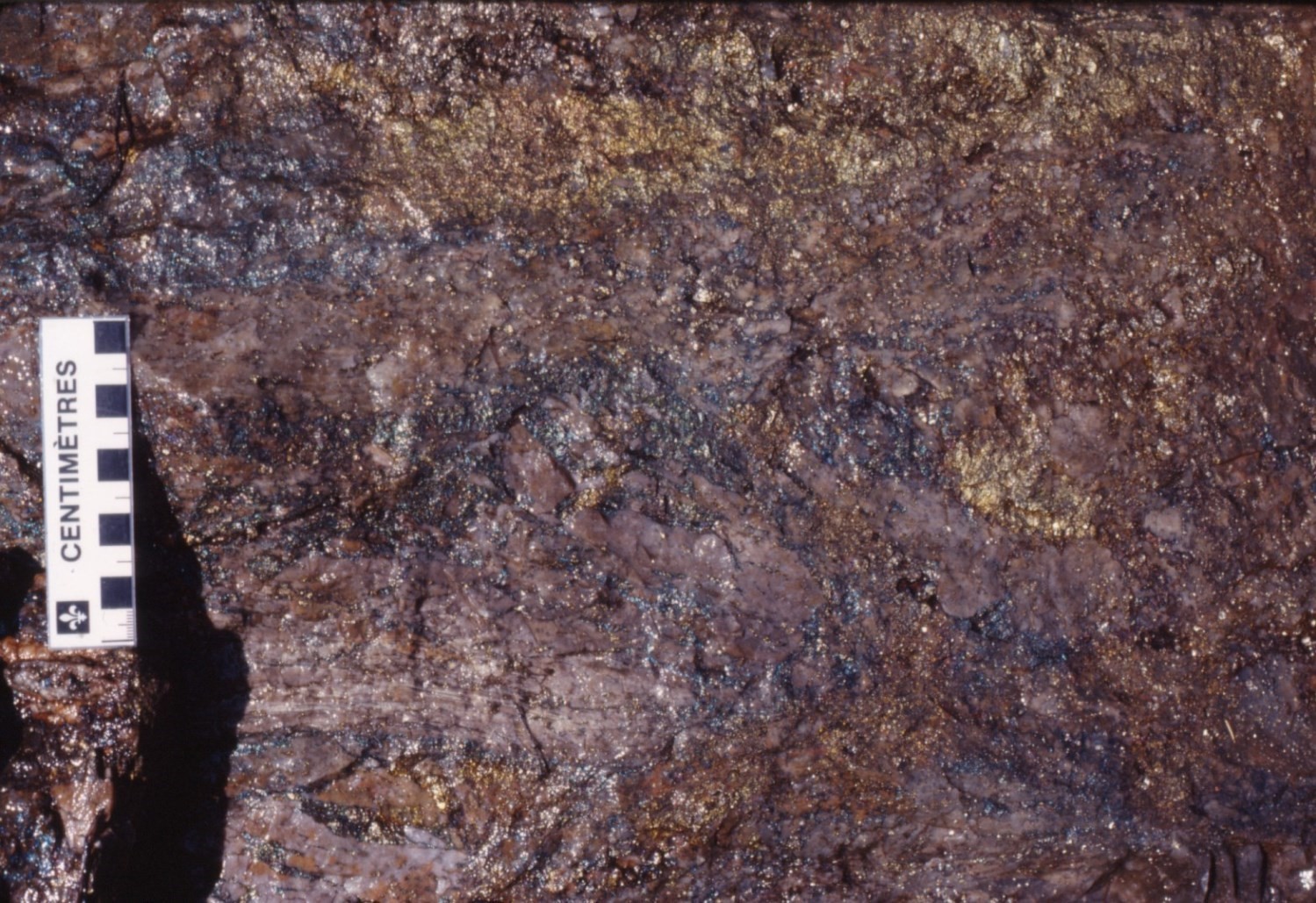 Laminated (or banded), fine-grained, locally sulphide-rich beige, grey, pinkish or black albitic rocks occur in the escarpment along the Romanet River at the Delhi Pacific mineralized site (sheet 24B05). The following description and interpretations are from Clark (1986). The rock, with Na2O contents ranging from 7 to 11%, forms a strip ~800 m long, and ranges in width from a few metres to ~45 m. The rock is interbedded with basalt and mudstone layers belonging to the Bacchus Formation and with thin gabbro sills. Traces of at least two major faults follow the escarpment. Albitic laminae (or bands) are millimetre to centimetre thick and strongly folded; they locally contain a significant amount of chalcopyrite, accompanied by pyrrhotite and pyrite. Sulphides are located in thin veins and small (millimetric) irregular clusters of relatively coarse-grained albitic rock compared to the surrounding albitic rocks. The sodic composition of laminae is interpreted as being of metasomatic origin and caused by the circulation of sodic hydrothermal fluids. The structures suggest that albite and sulphides were recrystallized. The original albitic rock was possibly mudstone or tuff. The initial development of sulphides was probably contemporaneous with sodic metasomatism. Structural and textural evidence suggests that metasomatism occurred during various folding episodes.
Laminated (or banded), fine-grained, locally sulphide-rich beige, grey, pinkish or black albitic rocks occur in the escarpment along the Romanet River at the Delhi Pacific mineralized site (sheet 24B05). The following description and interpretations are from Clark (1986). The rock, with Na2O contents ranging from 7 to 11%, forms a strip ~800 m long, and ranges in width from a few metres to ~45 m. The rock is interbedded with basalt and mudstone layers belonging to the Bacchus Formation and with thin gabbro sills. Traces of at least two major faults follow the escarpment. Albitic laminae (or bands) are millimetre to centimetre thick and strongly folded; they locally contain a significant amount of chalcopyrite, accompanied by pyrrhotite and pyrite. Sulphides are located in thin veins and small (millimetric) irregular clusters of relatively coarse-grained albitic rock compared to the surrounding albitic rocks. The sodic composition of laminae is interpreted as being of metasomatic origin and caused by the circulation of sodic hydrothermal fluids. The structures suggest that albite and sulphides were recrystallized. The original albitic rock was possibly mudstone or tuff. The initial development of sulphides was probably contemporaneous with sodic metasomatism. Structural and textural evidence suggests that metasomatism occurred during various folding episodes.
Mistamisk Complex 4 (pPmik4): Albitic Sodic Diorite
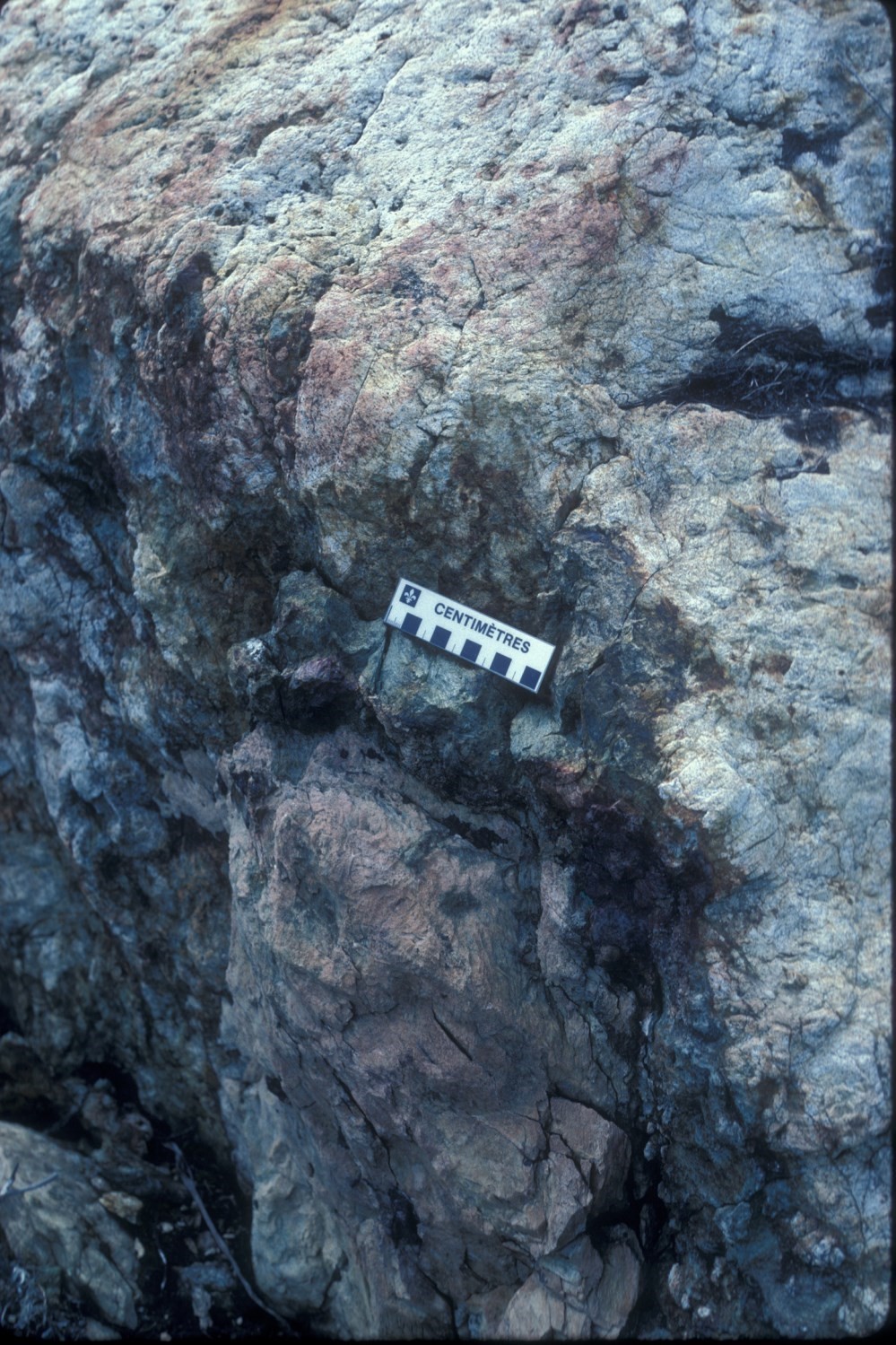 A decametric cluster of medium-grained albitic sodic diorite, hosted in volcano-sedimentary rocks of the Bacchus Formation, outcrops at the Lomer Copper mineralized site on the SW shore of Mistamisk Lake (sheet 24C08; Clark, 1986). This grey rock displaying a white, light beige or brown patina, locally spotted with red or pink, is associated with chloritic or carbonate matrix albitic breccias and extensive tremolite-actinolite or carbonate alteration. The rock is enriched in sodium (6.54% Na2O) and titanium (3.24% TiO2), and locally highly magnetic. It contains minor amounts of pyrite and chalcopyrite.
A decametric cluster of medium-grained albitic sodic diorite, hosted in volcano-sedimentary rocks of the Bacchus Formation, outcrops at the Lomer Copper mineralized site on the SW shore of Mistamisk Lake (sheet 24C08; Clark, 1986). This grey rock displaying a white, light beige or brown patina, locally spotted with red or pink, is associated with chloritic or carbonate matrix albitic breccias and extensive tremolite-actinolite or carbonate alteration. The rock is enriched in sodium (6.54% Na2O) and titanium (3.24% TiO2), and locally highly magnetic. It contains minor amounts of pyrite and chalcopyrite.
Thickness and distribution
The Mistamisk Complex, located in the Mistamisk and Romanet lakes’ valley, is confined between the faults that bound the Lac Romanet Horst (sheets 24B and 24C) (Le Gallais and Lavoie, 1982; Chevé, 1985; Clark, 1986). Outcrops of the complex extend over a distance of 23 km on a NW-SE axis. Albitic laminae associated with the complex are locally only 1 mm thick, while some breccia clusters and strips have apparent thicknesses of 50 to 400 m (Clark, 1986). One albitic breccia dyke (sheet 24B05) has a total length of ≥1 km.
Dating
None.
Stratigraphic Relationship(s)
Informal units of the Mistamisk Complex are in contact with several formations of the first volcano-sedimentary cycle of the Labrador Trough, namely the Dunphy, Lace Lake, Uvé, Du Chambon, Romanet and Bacchus formations. The complex is related to an episode of hydrothermal sodic metasomatism that affected these formations and occurred during regional deformation and metamorphism at ~1800 Ma (Kish and Cuney, 1981; Clark, 1986; Clark and Wares, 2004). The emplacement of the Mistamisk Complex would not be synchronous with either the Castignon Volcanic Complex or the Le Moyne Carbonatite Complex, which are contemporaneous with some of the Trough’s volcano-sedimentary units and therefore pre-tectonic.
Paleontology
Does not apply.
References
Publications Available Through SIGÉOM Examine
CHEVE, S R. 1985. LES INDICES MINERALISES DU LAC ROMANET, FOSSE DU LABRADOR. I N R S-GEORESSOURCES. ET 83-13, 62 pages and 2 plans.
CLARK, T. 1986. GEOLOGIE ET MINERALISATIONS DE LA REGION DU LAC MISTAMISK ET DE LA RIVIERE ROMANET. MRN. ET 83-22, 56 pages and 1 plan.
CLARK, T., WARES, R. 2004. SYNTHESE LITHOTECTONIQUE ET METALLOGENIQUE DE L’OROGENE DU NOUVEAU-QUEBEC (FOSSE DU LABRADOR). MRNFP. MM 2004-01, 182 pages and 1 plan.
CONLIFFE, J., CORRIVEAU, L., MONTREUIL, J.-F., BLEIN, O., 2019. Le potentiel minéral de la Fosse du Labrador pour les minéralisations d’oxydes de fer-cuivre-or (IOCG) et les dépôts associés. Dans : MERN. 2020. Résumés des conférences et des photoprésentations, Québec Mines+Énergie 2019. DV 2019-01, 78 pages.
DIMROTH, E. 1978. REGION DE LA FOSSE DU LABRADOR ENTRE LES LATITUDES 54° 30′ ET 56° 30′. MRN. RG 193, 417 pages and 16 plans.
KEARVELL, G. 1985. BRECHES ET ALTERATIONS ALBITIQUES DE LA RIVIERE ROMANET-FOSSE DU LABRADOR. MRN. DP-85-24, 2 plans.
KEARVELL, G., CLARK, T. 1987. ETUDE D’INDICES Au – U ET DE BRECHES POLYGENIQUES DANS LA VALLEE DES LACS MISTAMISK ET ROMANET – FOSSE DU LABRADOR -. MRN. DP-87-24, 32 pages and 1 plan.
LAFRANCE, I., CHARETTE, B. 2015. Géologie de la région du lac Jeannin. MERN. BG 2015-01, 1 plan.
Other Publications
KISH, L., CUNEY, M., 1981. Uraninite-albite veins from the Mistamisk valley of the Labrador Trough, Quebec. Mineralogical Magazine, volume 44, pages 471-483. doi.org/10.1180/minmag.1981.044.336.13
LE GALLAIS, C.J., LAVOIE, S., 1982. Basin evolution of the Lower Proterozoic Kaniapiskau Supergroup, central Labrador miogeocline (Trough), Quebec. Bulletin of Canadian Petroleum Geology, volume 30, pages 150-166. http://bcpg.geoscienceworld.org/content/30/2/150
Suggested Citation
Ministère de l’Énergie et des Ressources naturelles (MERN). Mistamisk Complex. Quebec Stratigraphic Lexicon. https://gq.mines.gouv.qc.ca/lexique-stratigraphique/province-de-churchill/complexe-de-mistamisk_en [accessed on Day Month Year].
Contributors
|
First publication |
Thomas Clark, P. Geo., Ph.D. (redaction) Mehdi A. Guemache, P. Geo., Ph.D. (coordination); Charles St-Hilaire, GIT, M.Sc. (critical review); Simon Auclair, P. Geo., M.Sc. (editing); Céline Dupuis, P. Geo., Ph.D. (English version); André Tremblay (HTML editing). |

